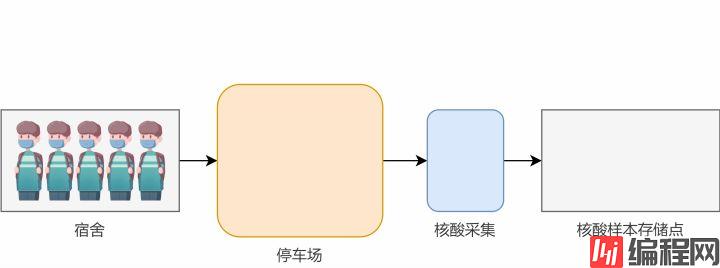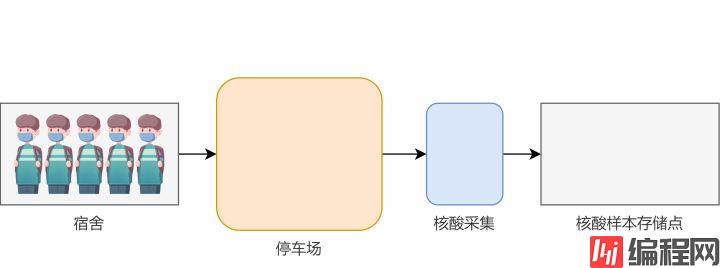Python 官方文档:入门教程 => 点击学习
目录学生数量特别少的情况停车场空间不够时怎么办?怎么加快执行效率?怎么加快处理速度?结语故事背景:最近在处理Wikipedia的数据时发现由于数据量过大,之前的文件读取和数据处理方法
故事背景:最近在处理Wikipedia的数据时发现由于数据量过大,之前的文件读取和数据处理方法几乎不可用,或耗时非常久。今天学校安排统一核酸检查,刚好和文件读取的过程非常相似。正好借此机会和大家一起从头梳理一下几种文件读取方法。
故事设定:现在学校要求对所有同学进行核酸采集,每位同学先在宿舍内等候防护人员(以下简称“大白”)叫号,叫到自己时去停车场排队等候大白对自己进行采集,采集完之后的样本由大白统一有序收集并储存。
名词解释:
当学生数量特别少时,可以考虑将所有学生统一叫到停车场等候,再依次进行核酸采集。

方法一:简单情况
此时的程序可以模拟为:
import time
from typing import List
def pick_all_students(dORM: str) -> List[str]:
with open(dorm, "rt", encoding="utf8") as fin:
students = fin.readlines()
return students
def pick_sample(student: str) -> str:
time.sleep(0.01)
sample = f"{student.strip()}'s sample"
return sample
def process(dorm: str, sample_storeroom: str) -> None:
with open(sample_storeroom, "wt", encoding="utf8") as fout:
students = pick_all_students(dorm)
for student in students:
sample = pick_sample(student)
fout.write(f"{sample}\n")
fout.flush()
if __name__ == "__main__":
process(
"student_names.txt",
"sample_storeroom.txt"
)
注意,在第19行中,大白一次性把所有同学都叫到了停车场中。这种做法在学生比较少时做起来很快,但是如果学生特别多,停车场装不下怎么办?

方法二:边读边处理
一般来说,由于停车场空间有限,我们不会采用一次性把所有学生都叫到停车场中,而是会一个一个地处理,这样可以节约内存空间。
import time
from typing import Iterator
def pick_one_student(dorm: str) -> Iterator[str]:
with open(dorm, "rt", encoding="utf8") as fin:
for student in fin:
yield student
def pick_sample(student: str) -> str:
time.sleep(0.01)
sample = f"{student.strip()}'s sample"
return sample
def process(dorm: str, sample_storeroom: str) -> None:
with open(sample_storeroom, "wt", encoding="utf8") as fout:
for student in pick_one_student(dorm):
sample = pick_sample(student)
fout.write(f"{sample}\n")
fout.flush()
if __name__ == "__main__":
process(
"student_names.txt",
"sample_storeroom.txt"
)
这里pick_one_student函数中的返回值是用yield返回的,一次只会返回一名同学。
不过,这种做法虽然确保了停车场不会满员,但是这种做法在人数特别多的时候就不再适合了。虽然可以保证完成任务,但由于每次只能采集一个同学,程序的执行并不高。特别是当你的CPU有多个核时,会浪费机器性能,出现一核有难,其它围观的现象。

大家可能也已经注意到了,刚刚我们的场景中,不论采用哪种方法,都只有一名大白在工作。那我们能不能加派人手,从而提高效率呢?
答案当然是可行的。我们现在先考虑增加两名大白,使得一名大白专注于叫号,安排学生进入停车场,另外一名大白专注于采集核酸,最后一名大白用于存储核酸样本。

方法三
import time
from multiprocessing import Queue, Process
from typing import Iterator
def pick_student(stu_queue: Queue, dorm: str) -> Iterator[str]:
print("pick_student: started")
picked_num = 0
with open(dorm, "rt", encoding="utf8") as fin:
for student in fin:
stu_queue.put(student)
picked_num += 1
if picked_num % 500 == 0:
print(f"pick_student: {picked_num}")
# end signal
stu_queue.put(None)
print("pick_student: finished")
def pick_sample(student: str) -> str:
time.sleep(0.01)
sample = f"{student.strip()}'s sample"
return sample
def process(stu_queue: Queue, store_queue: Queue) -> None:
print("process: started")
process_num = 0
while True:
student = stu_queue.get()
if student is not None:
sample = pick_sample(student)
store_queue.put(sample)
process_num += 1
if process_num % 500 == 0:
print(f"process: {process_num}")
else:
break
# end signal
store_queue.put(None)
print("process: finished")
def store_sample(store_queue: Queue, sample_storeroom: str) -> None:
print("store_sample: started")
store_num = 0
with open(sample_storeroom, "wt", encoding="utf8") as fout:
while True:
sample = store_queue.get()
if sample is not None:
fout.write(f"{sample}\n")
fout.flush()
store_num += 1
if store_num % 500 == 0:
print(f"store_sample: {store_num}")
else:
break
print("store_sample: finished")
if __name__ == "__main__":
dorm = "student_names.txt"
sample_storeroom = "sample_storeroom.txt"
stu_queue = Queue()
store_queue = Queue()
store_p = Process(target=store_sample, args=(store_queue, sample_storeroom), daemon=True)
store_p.start()
process_p = Process(target=process, args=(stu_queue, store_queue), daemon=True)
process_p.start()
read_p = Process(target=pick_student, args=(stu_queue, dorm), daemon=True)
read_p.start()
store_p.join()
这份代码中,我们引入了多进程的思路,将每个大白看作一个进程,并使用了队列Queue作为进程间通信的媒介。stu_queue表示学生叫号进停车场的队列,store_queue表示已经采集过的待存储核酸样本的队列。
此外,为了控制进程的停止,我们在pick_student和 process函数的最后都向各自队列中添加了None作为结束标志符。
假设有1w名学生(student_names.txt文件有1w行),经过测试后发现上述方法的时间如下:
咦?不是做了分工吗?怎么速度还变慢了?经笔者观察,这是因为叫号的大白速度太快了(文件读取速度快)通常是TA已经齐活了,另外俩人还在吭哧吭哧干活呢,体现不出来分工的优势。如果这个时候我们对法二和法三的叫号做延时操作,每个学生叫号之后停滞10ms再叫下一位学生,则方法三的处理时间几乎不变,而方法二的时间则会延长至3m21.345s。
上面提到,大白采核酸的时间较长,往往上一个人的核酸还没采完,下一个人就已经在后面等着了。我们能不能提高核酸采集这个动作(数据处理)的速度呢?其实一名大白执行一次核酸采集的时间我们几乎无法再缩短了,但是我们可以通过增加人手的方式,来达到这个目的。就像去银行办业务,如果开放的窗口越多,那么每个人等待的时间就会越短。这里我们也采取类似的策略,增加核酸采集的窗口。

import time
from multiprocessing import Queue, Process, cpu_count
from typing import Iterator
def pick_student(stu_queue: Queue, dorm: str, num_workers: int) -> Iterator[str]:
print("pick_student: started")
picked_num = 0
with open(dorm, "rt", encoding="utf8") as fin:
for student in fin:
stu_queue.put(student)
picked_num += 1
if picked_num % 500 == 0:
print(f"pick_student: {picked_num}")
# end signal
for _ in range(num_workers):
stu_queue.put(None)
print("pick_student: finished")
def pick_sample(student: str) -> str:
time.sleep(0.01)
sample = f"{student.strip()}'s sample"
return sample
def process(stu_queue: Queue, store_queue: Queue) -> None:
print("process: started")
process_num = 0
while True:
student = stu_queue.get()
if student is not None:
sample = pick_sample(student)
store_queue.put(sample)
process_num += 1
if process_num % 500 == 0:
print(f"process: {process_num}")
else:
break
print("process: finished")
def store_sample(store_queue: Queue, sample_storeroom: str) -> None:
print("store_sample: started")
store_num = 0
with open(sample_storeroom, "wt", encoding="utf8") as fout:
while True:
sample = store_queue.get()
if sample is not None:
fout.write(f"{sample}\n")
fout.flush()
store_num += 1
if store_num % 500 == 0:
print(f"store_sample: {store_num}")
else:
break
print("store_sample: finished")
if __name__ == "__main__":
dorm = "student_names.txt"
sample_storeroom = "sample_storeroom.txt"
num_process = max(1, cpu_count() - 1)
maxsize = 10 * num_process
stu_queue = Queue(maxsize=maxsize)
store_queue = Queue(maxsize=maxsize)
store_p = Process(target=store_sample, args=(store_queue, sample_storeroom), daemon=True)
store_p.start()
process_workers = []
for _ in range(num_process):
process_p = Process(target=process, args=(stu_queue, store_queue), daemon=True)
process_p.start()
process_workers.append(process_p)
read_p = Process(target=pick_student, args=(stu_queue, dorm, num_process), daemon=True)
read_p.start()
for worker in process_workers:
worker.join()
# end signal
store_queue.put(None)
store_p.join()总耗时 0m4.160s !我们来具体看看其中的细节部分:
首先我们将CPU核数 - 3作为采核酸的大白数量。这里减3是为其它工作进程保留了一些资源,你也可以根据自己的具体情况做调整
这次我们在 Queue中增加了 maxsize参数,这个参数是限制队列的最大长度,这个参数通常与你的实际内存情况有关。如果数据特别多时要考虑做些调整。这里我采用10倍的工作进程数目作为队列的长度
注意这里pick_student函数中要为每个后续的工作进程都添加一个结束标志,因此最后会有个for循环
我们把之前放在process函数中的结束标志提取出来,放在了最外侧,使得所有工作进程均结束之后再关闭最后的store_p进程
总结来说,如果你的数据集特别小,用法一;通常情况下用法二;数据集特别大时用法四。
以上就是python读取文件的四种方式的实例详解的详细内容,更多关于Python读取文件的资料请关注编程网其它相关文章!
--结束END--
本文标题: Python读取文件的四种方式的实例详解
本文链接: https://lsjlt.com/news/143900.html(转载时请注明来源链接)
有问题或投稿请发送至: 邮箱/279061341@qq.com QQ/279061341
2024-03-01
2024-03-01
2024-03-01
2024-02-29
2024-02-29
2024-02-29
2024-02-29
2024-02-29
2024-02-29
2024-02-29
回答
回答
回答
回答
回答
回答
回答
回答
回答
回答
0